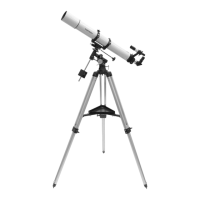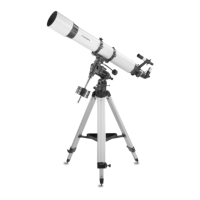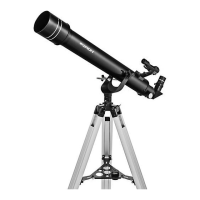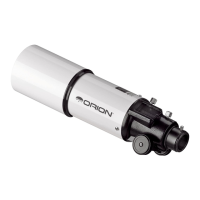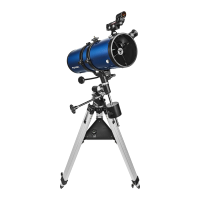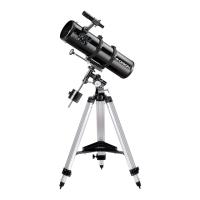12
Other Functions
The Atlas EQ-G hand controller is equipped with a variety of
additional functions that allow you to optimize performance
and access other features of the system.
Utility Functions
Utility Functions are useful tools that provide simple, one-step
processes to your Atlas EQ-G.
Show Position: This function displays the coordinates (Right
Ascension and Declination) of the location where the tele-
scope mounted on the Atlas EQ-G is currently pointing.
Display Time: This function displays the local time and local
Sidereal time.
Park Scope: This function moves the telescope to the Home
position. This allows you to power off the Atlas EQ-G while
saving PEC training data (See Appendix B).
RS-232 Mode: This allows linking with a computer. (See
“Linking with a Computer”).
PEC Training: See appendix B for information
Setup Functions
The Setup functions allow you to change any system variable
or information regarding location, time, date, and alignment
configurations. To access the Setup Functions, either press
the SETUP button on the hand controller or scroll to SETUP
MODE under the menu option using the scroll keys. The dif-
ferent types of functions available to you are listed below,
along with their respective purposes.
Date: Allows you to change the date entered at the initial
setup.
Time: Allows you to change the current time.
Observing site: Allows you to change the current location
setting.
Daylight Savings: Allows you to change the Daylight Savings
option.
Alignment: Allows you to re-perform the star alignment, (see
“Alignment”).
Set Backlash: This function allows you to insert a value for
each axis to compensate for slewing backlash experienced
on that axis. Backlash is a delay in motorized motion of the
mount due to slack between gears. Backlash is experienced
when the slewing direction is reversed on one or both axes
of motion. For improved pointing accuracy, it is important the
backlash value is set to be equal or greater than the actual
amount of backlash between the gears. If the actual amount
of backlash is unknown, we recommend that you set the
value to 5000 (approximately equivalent to 0.2°). First set the
value for R.A. backlash, then press ENTER to set the value
for DEC.
Note: Backlash compensation is only active for computer-
ized slewing, not for manual slewing with the directional
buttons.
Set Tracking:
-Sid. Rate: Activates tracking at sidereal rate This is the
default tracking rate.
-Lunar Rate: Activates tracking at lunar rate.
-Solar Rate: Activates tracking at solar rate.
-PEC + Sidereal Rate: Activates sidereal rate tracking
with Periodic Error Compensation.
-Stop Tracking: Stops tracking.
Auto Guide Speed: When using an autoguider, this sets the
guiding speed to 1.25X, 1.5X, 1.75X, or 2X sidereal rate.
Using the User-Defined Database
The Atlas EQ-G allows you to save up to 25 objects in the
User Defined Database. You can save unidentifiable objects,
current comet and/or asteroid positions, or make a custom list
of your favorite objects to view.
Saving an Object to the Database
1. Press the USER button or select USER DEFINED under
the object catalog menu. Press ENTER.
2. Choose INPUT COORDINATE and press ENTER.
3. You can enter the chosen object’s location by its R.A.
and DEC coordinates, or telescope altitude and azimuth
coordinates. Press 1 (R.A. and DEC) or 2 (Altitude and
Azimuth) to make your selection. The default setting of
the Atlas EQ-G will display the R.A./DEC or Alt/Az coor-
dinates the telescope is currently pinted to. Change the
coordinates using the numeric buttons and scroll buttons.
Press ENTER to save the chosen setting.
4. The Atlas EQ-G will prompt you to choose a number
between 1 to 25 for your chosen object. Press ENTER
again, then select the number you wish to represent the
object, using the scroll buttons. Press ENTER to confirm.
5. The hand controller will now display “View Object?”. Press
ENTER to slew the telescope to the object. Press ESC to
exit.
Selecting a User-Defined Object
1. Press the USER button or select USER DEFINED under
the object catalog. Press ENTER.
2. Choose RECALL OBJECT and press ENTER to confirm.
3. Select the number representing the object you wish to
view, using the scroll buttons. Press ENTER to display the
object’s coordinate. Press ENTER once more to choose
the object.
4. The Atlas EQ-G will display “View Object?”. Press ENTER
to slew the telescope to the coordinate. Press ESC to
exit.
Identifying an Unknown Object
The Atlas EQ-G has the ability to identify celestial objects that
are unknown to you. To identify an object that the telescope is
centered on, simply press the ID key or scroll to IDENTIFY in
the main menu and press ENTER to identify the object.
